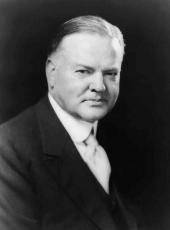MILITARY NEEDS AND EXPENDITURES
THE PRESIDENT. Last week there was published a statement of information that I gave to you on the estimated increase of Federal expenditure [p.230] over the next 4 years as imposed by legislation already passed by Congress. Those estimates indicated that by 1933 an increased burden of somewhere from 250 to 300 million over the expenditures of the fiscal year that has just passed and somewhere from 400 million to 500 million above the expenditures of 4 years ago.
Now of this, the purely military expenditure--that is, excluding all the nonmilitary activities of the two departments--represents just about one-half of the increases. The total military expenditure, that is, Army and Navy combined, was estimated at 803 million as shown on the sheet I gave you last time, for 1933. It is an increase of about 120 million over that of the last fiscal year and about 224 million over 4 years ago. All of which compares with a total of about 266 million, the average 3-year prewar expenditure, for military activities of the Army and Navy, or an increase by 1933 of about 530 million a year.
These amounts do not include any of the money that we justly spend on veterans and pensions, which in themselves amount to about 820 million a year.
The American people should understand that current expenditure of the Army and Navy constitutes the largest military budget of any nation in the world today, and at a time when there is less real danger of extensive disturbance of peace than at any time in more than half a century.
Moreover, there are many bills pending by the Congress that will increase this expenditure. The hope of tax reduction lies very largely in the ability to economize military expenditure and still maintain an adequate defense. Our national situation is considerably modified by the Kellogg Pact. We hope, growing out of that--negotiations we have in progress--to save materially on naval expenditure by international agreement in reduction of naval arms.
In the matter of the Army outlay I am in agreement with the Secretary of War to set up, within the General Staff, a commission of leading Army officers to reconsider the whole of our Army program over the next 4 years, to see what services and other outlays have become obsolete through the development of science and war methods, what development programs can well be considered over longer periods, always in [p.231] view of the general world outlook, and at the same time that we should maintain a completely adequate preparedness; thereby to conduct an investigation that will be entirely constructive and not in any sense
destructive of defense. If you like you can quote that.
Q. May we have copies, Mr. President ?
THE PRESIDENT. Yes.
WITHDRAWAL FROM NICARAGUA
There is one other little item. We have decided today to withdraw 1,200 more marines from Nicaragua. Twelve hundred out of 3,500 leaves 2,300 approximately.
Q. Mr. President, is there any reason for that--more peaceful down there ?
THE PRESIDENT. Order is gradually being established and we are withdrawing the marines as fast as we can. That is all I have on my mind.
Note: President Hoover's fortieth news conference was held in the White House at 12 noon on Tuesday, July 23, 1929. The White House also issued a text of the President's statement on military expenditures (see Item 160).
Herbert Hoover, The President's News Conference Online by Gerhard Peters and John T. Woolley, The American Presidency Project https://www.presidency.ucsb.edu/node/210959


